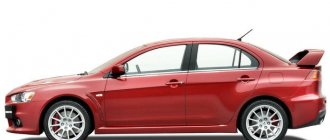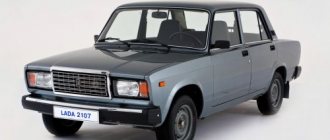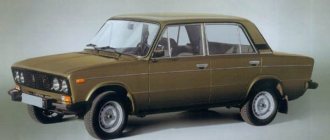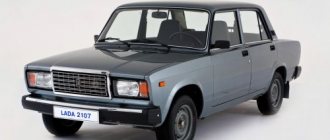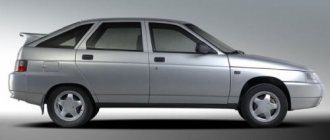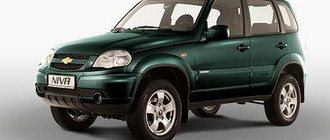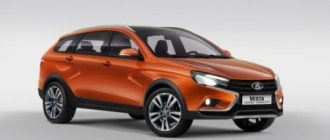Japanese company Mitsubishi
But first, let's say a few words about the company that produced this incredibly stylish and powerful car. Mitsubishi Motors Corporation is a famous Japanese company engaged in the creation of automobiles. It is believed that its founder was Yataro Iwasaki. It is the image of his family coat of arms that underlies the Mitsubishi symbol. This is the well-known shamrock - three diamond-shaped oak leaves arranged in the shape of a flower. The company's headquarters is located in Tokyo.
| Engine | Consumption (highway) | Consumption (city) | Consumption (mixed cycle) |
| 1.6 MIVEC 5-mech | 5.2 l/100 km | 8 l/100 km | 6.2 l/100 km |
| 1.6 MIVEC 4-auto | 6.1 l/100 km | 8 l/100 km | 7.3 l/100 km |
| 1.5 MIVEC | 6 l/100 km | 8.9 l/100 km | 7 l/100 km |
| 1.8 MIVEC | 6.1 l/100 km | 10.3 l/100 km | 7.6 l/100 km |
| 2.0 MIVEC | 6.6 l/100 km | 10.8 l/100 km | 8.1 l/100 km |
| 2.4 MIVEC | 8.4 l/100 km | 11.2 l/100 km | 10.2 l/100 km |
| 1.8 DI-D | 4.4 l/100 km | 6.2 l/100 km | 5.2 l/100 km |
| 2.0 DI-D | 5.2 l/100 km | 8.5 l/100 km | 6.4 l/100 km |
| 1.8 DI-D | 4.8 l/100 km | 6.8 l/100 km | 5.5 l/100 km |
Now the company is developing steadily. It has produced several world-famous series of machines that are respected throughout the world. These are ASX, Outlander, Lancer, Pajero Sport. One of the features of these cars is economical fuel consumption when driving on the highway.
Over the course of a year, the company manages to produce more than one and a half million “iron horses,” which are sold in one hundred and sixty countries around the world. And this is not the limit. The company continues to increase its turnover.
Lancer history
Pioneer
One of the most famous, successful and sought-after Mitsubishi series is Lancer. The first swallow of the line - the A70 model - saw the world at the end of winter 1973. It was produced in the following body styles:
- sedan with 2 doors;
- sedan with 4 doors;
- station wagon with 5 doors.
The engine size also varied (the larger the volume, the greater the fuel consumption):
- 1.2 liters;
- 1.4 liters;
- 1.6 liters.
Generation number two
In 1979, a new Lancer series appeared - EX. At first it was equipped with engines that could have three displacement options:
- 1.4 l (power - 80 horsepower);
- 1.6 l (85 horsepower);
- 1.6 l (100 horsepower).
But, a year later, another Lancer model appeared in the lineup with a more powerful engine - 1.8 liters. In addition, sports cars with other engines were produced.
In terms of fuel consumption, even the second generation Mitsubishi Lancer was very economical. The fuel consumption test, which passenger cars underwent in ten modes, showed fuel consumption of only 4.5 liters per 100 kilometers
. Well, if the Lancer owner drove mainly at a speed of 60 km per hour, then the fuel consumption was 3.12 liters per 100 km.
Third knee
The car of the third “level” appeared in 1982 and was called Lancer Fiore, had two body options:
- hatchback (since 1982);
- station wagon (since 1985).
Such Lancers were produced until 2008. A feature of this line was that the cars began to be equipped with turbocharging, as well as an injector. Like the previous ones, they were equipped with engines of different sizes, on which fuel consumption depended:
- 1.3 l;
- 1.5 l;
- 1.8 l.
Fourth generation
From 1982 to 1988, the fourth “circle” was updated. Externally, these cars began to be distinguished by the presence of diagonal lights. Engine modifications were as follows:
- sedan, 1.5 l;
- sedan, 1.6 l,
- sedan, 1.8 l;
- sedan diesel;
- station wagon, 1.8 l.
Attempt number five
Already in 1983, a new Lancer model appeared. Outwardly, she became much more interesting than her predecessors and almost immediately gained enormous popularity. The car was produced in four body styles:
- sedan;
- hatchback;
- station wagon;
- coupe.
Also, the future owner could choose the desired engine size:
- 1.3 l;
- 1.5 l;
- 1.6 l;
- 1.8 l;
- 2.0 l.
The gearbox could be 4 or 5 speed. Also, some models were produced with a three-speed automatic transmission, which greatly simplified driving.
Mitsubishi Lancer 8th generation
The 8th generation Mitsubishi Lancer was produced from 1996 to 2003. Cars of this generation were available in sedan body type, and sometimes coupes were also available. For consumers in European countries, configurations with gasoline engines of 1.3 liters (power 69 hp) and 1.6 liters (power 120 and 124 hp) were offered.
Reviews of the real consumption of Mitsubishi Lancer VIII
- Ruslan, Makhachkala. I bought a 2003 Mitsubishi Lancer, 1.6 liter engine. Despite the small volume, I am completely satisfied with the car, because I am not a fan of driving. And for a calm, measured ride it is quite enough. Even the fact that I didn’t buy it new did not in any way affect its driving performance. Consumption for a sedan is quite normal - up to 10 liters.
- Igor, Yaroslavl. At the time of choosing a car, I did not expect more than a budget option. And the 2001 Mitsubishi Lancer fits perfectly into my calculations. The fact that the year of manufacture is old does not harm the car. Good ride, dynamics, comfortable fit. Ten liters of gasoline are enough for 170-180 km. Engine 1.6 l.
- Oleg, Syzran. I have a 2002 Mitsubishi Lancer, 1.6 liter engine, automatic transmission. The car is decent, but there are a lot of shortcomings. Sometimes it jerks when changing gears, the power is not enough for me. But fuel consumption is quite economical, at low speeds about 6 liters.
- Vladislav, Perm. My father gave me a 2000 Mitsubishi Lancer, 1.3 liter. Everyone already knows about the qualities of the “Japanese”; I measured fuel consumption. On good roads, consumption is around 6-6.5 liters, unfortunately, there are few of them. On normal roads it takes up to 10-11 liters of gasoline.
- Vladimir, Kostroma. I bought the 2001 Mitsubishi Lancer new, and now I have driven more than 270 thousand km. So far it is undergoing routine scheduled maintenance; nothing else has been done to the car. Reliable, unbreakable, unpretentious machine. Fuel consumption is about 8-9 liters on average. Engine 1.3 l.
- Andrey, Irkutsk. Before the Mitsubishi Lancer, I had a two-liter Honda Civic. Of course, there is a difference, but the power of the 1.6-liter Lancer is quite enough for me. It behaves well on the road and does not consume much - from 8 liters outside the city to 11-12 liters in the city. Model 1999 release.
- Gregory, Vologda. I've been driving a Mitsubishi Lancer 2000 for five years now. During all this time I hardly climbed under the hood. Consumables and oil - that's all replacement. The car is indestructible, drives in any weather. In the city I consume up to 12 liters, on the highway 6-8 liters, depending on the quality of the road surface.
Other cars: Nissan Serena fuel consumption reviews
Mitsubishi Lancer 6
The sixth series first appeared in 1991. The company has provided many modifications to this line. Thus, it was possible to purchase cars with an engine capacity from 1.3 liters to 2.0 liters. The most powerful one ran on diesel fuel, all the others ran on gasoline. They also had slightly different bodies: there were two- and four-door versions, sedans and station wagons.
Lucky number seven
The seventh generation became available to buyers in the early nineties. While maintaining the original design style of its predecessors, the car became even more like a sports car. At the same time, the aerodynamic drag became even lower and reached 0.3. The Japanese improved the suspension and added airbags.
Eighth, ninth and tenth generations
It appeared in the year two thousand. The appearance of the car has become even more interesting and noticeable. Buyers from all over the world can purchase a model with a manual or automatic transmission. This car was produced for three years.
And in 2003, a new product appeared - Lancer 9. Well, ten months later the Japanese improved the “heart” of the car, increasing its volume to 2.0 liters. This car has become very popular.
But even it was “outdone” by the tenth version of Lancer. The company presented several types of engine power and body styles. So anyone who always strives to be on top and keep up with the latest automotive innovations can safely choose Lancer X. This car will emphasize the style, status and good taste of its owner.
Mitsubishi Lancer 9th generation
The 9th generation Lancers rolled off the assembly line from 2003 to 2009 and were available in sedan and station wagon bodies. Although the Cedia model, which has been sold since 2000, is also considered to be a ninth-generation car. The engine line was represented by gasoline engines of 1.3 liters (69 hp), 1.6 liters (120 and 124 hp) and 2.0 liters (170 hp). In North America, cars with 2.4 liter engines (164 hp) were popular.
Reviews of the real consumption of Mitsubishi Lancer IX
- Anatoly, Moscow. I purchased a ninth generation Mitsubishi Lancer 2004 with a 1.5 liter engine. Of course, this sedan is far from a sports car, and the engine power is not for high speeds. But 6-7 liters of gasoline per hundred kilometers is a very economical option.
- Sergey, St. Petersburg. I bought a car from the second owner, I had to work on it, but only a little, because Mitsubishi is a very high-quality equipment. The mechanical component is excellent. On good roads it consumes about 6-6.5 liters per hundred, even with air conditioning. Model 2007, 1.6, manual.
- Artem, N. Novgorod. Mitsubishi Lancer 2003, 1.5, manual. Before him, I drove a liter Matiz. Of course, these are completely different cars in terms of reliability, dynamics, and comfort. But they have one thing in common - consumption from 5 to 7 liters. But the Lancer only needs 95 gasoline.
- Alexey, Saratov. My Mitsubishi Lancer has a 1.8 liter CVT engine. Of course, the power is at the level, and it accelerates without strain. If I drive alone, I spend about 11 liters in the city, but when four passengers are seated, it already goes up to 13-14 liters. It seems to me that this is too much.
- Boris, Omsk. I am the owner of a Mitsubishi Lancer 1.6, automatic transmission, 2008 model. When traveling long distances, I specifically measure fuel consumption. At a speed of 80-90 km/h it takes about 6.5 liters. The higher the speed, the higher the consumption. In the city it reaches 11 liters.
- Bogdan, Tula. Since I often have to travel around the country on business trips, I decided to buy a car. The criteria were: power, reliability, economical consumption. Mitsubishi Lancer of the ninth generation 2008 with a 1.8 engine came just in time. Within 100 km/h, about 9-10 liters are consumed, up to 150 km/h consumption increases to 14 liters.
- Stepan, Tambov. My Mitsubishi Lancer is equipped with a 1.6 liter engine paired with an automatic transmission. This car can rightfully be called a city car. Its consumption is very economical - on the highway 6-7 liters, in the city up to 10 liters of gasoline. Air conditioning and driving in traffic jams increase consumption just a little.
Other cars: Toyota Hiace fuel consumption
Well, now let’s pay special attention to the latest models of the Japanese automobile industry.
Mitsubishi Lancer 9
Before buying a car, did you read many forums where the “pros” and “cons” of the ninth generation Lancer were discussed? Then, for sure, you know that the manufacturer of this series took good care of the safety of the driver and passengers, equipping the car with a reliable chassis, high-quality suspension, an effective braking system, an ABS system and much more.
The Japanese also did a good job on the engine. It is made of high-quality alloys and has low toxicity. Its use of fuel is very economical, so its consumption is low. If you look at the technical specifications, you will find out that in the ninth generation on average
:
- Mitsubishi Lancer fuel costs in the city are 8.5 liters per 100 kilometers if a manual transmission is installed, and 10.3 liters if automatic;
- The average gasoline consumption of the Lancer 9 on the highway is much less and is 5.3 liters with a manual transmission, and 6.4 liters with an automatic transmission.
As you can see, the car does not “eat” a very large amount of fuel. Actual fuel consumption may differ slightly from the data indicated in the technical specifications.
Mitsubishi Lancer 10
Style, sport, modernity, originality - these are the characteristics of the appearance of the tenth generation of Lancers. The peculiar, even slightly aggressive, appearance of the tenth Lancer, reminiscent of a shark’s gaze, is its undeniable “highlight” that cannot but be remembered. Well, the high-quality materials that cover the car’s interior will not leave anyone indifferent.
The manufacturer offers models with automatic and manual transmissions. Numerous airbags guarantee a high level of safety. A nice feature is the low fuel consumption.
Fuel consumption
Let's take a closer look at the gasoline consumption of the Mitsubishi Lancer 10. As in the Nine, it differs for cars with a manual and automatic transmission. Fuel consumption for a Mitsubishi Lancer 10 with an engine capacity of 1.5 liters is
:
- in the city - 8.2 l (manual transmission), 9 l (automatic transmission);
- on the highway - 5.4 l (manual transmission), 6 l (automatic).
Let us note again that these are technical data. Actual fuel consumption of Lancer 10 per 100 km may vary. It depends on the quality of the fuel and driving style.
How to “reduce appetites” for cars
You can make your car use less gas. To reduce fuel consumption, you need to follow a few simple rules:
- Keep the fuel filters clean at all times. When they become clogged, the amount of gasoline consumed increases by at least three percent.
- Use properly selected quality oil.
- Make sure that the air pressure in the wheels is appropriate. Even with slightly flat tires, fuel consumption increases.
That's all! We reviewed the history of Mitsubishi Lancer cars and answered questions about Mitsubishi Lancer fuel consumption.
Mitsubishi Lancer 10th generation
At the beginning of 2007, the 10th generation Mitsubishi Lancer was introduced, which has a sportier look. Today, the production of hatchbacks and sedans continues. The model was updated in 2011. The choice of engines varies from a 1.5-liter 109-horsepower engine to a 2.0-liter 150-horsepower engine.
Reviews of the real consumption of Mitsubishi Lancer X
- Sergey, Nakhodka. I had a 2011 Mitsubishi Lancer with a 1.5-liter engine and an automatic transmission. I recently sold it because it doesn't have enough power and doesn't accelerate fast enough for me. But the consumption is such (8 liters outside the city), as if the engine was twice as powerful. There are cars with lower consumption, so I don’t regret selling them.
- Pavel, Ulyanovsk. In 2011 I bought a Mitsubishi Lancer 9, 2010, 1.5 l, manual. I have been riding for 5 years, of which I have been working as a taxi driver for two years. I drive 200 kilometers a day, 18-20 liters of gasoline are enough per day. I really like the car, there are no breakdowns.
- Andrey, Ust-Kamenogorsk. For a long time I had a 1.8-liter Toyota 2001. I wanted something newer, but from a different brand. Since I am a supporter of Japanese technology, I bought the latest generation Mitsubishi Lancer, 2010, automatic, 1.6. Toyota took 21-22 liters for 200 kilometers, the Lancer is a little more economical - 18-19 liters.
- Vladimir, Samara. Mitsubishi Lancer 1.6, 120 “horses”. For a quiet ride around the city, Lancer is the best option. It doesn’t stall, it overtakes confidently, and its maneuverability is on par. The engine power is enough for changing lanes and for country roads. And the consumption is small - 6-7 liters on the highway, 9-10 liters in the city.
- Rostislav, Moscow. I like to drive fast, so I took a Mitsubishi Lancer with a 2.4 liter engine in the hope of more power and good acceleration. It’s a pity that the rules have become stricter and fines are being issued more often. And consumption increases at speeds - up to 13 liters in summer and up to 16 liters in winter.
- Kirill, Bryansk. Mitsubishi Lancer 2013, 2.0 liter, manual. I'm an ordinary driver, not a racer, but not a slow-moving one either. The average speed on the highway is 120 km/h. At this speed, 7.5 liters of gasoline are consumed. In the city at night 10 liters, during the day with traffic jams 11-12 liters.
- Roman, Peter. I have a 2012 Mitsubishi Lancer, 1.8, CVT. I love speed, but I also want to save on costs. The car is just for people like me. On average I spend about 12 liters, which I consider quite normal for a car of this class.
Other cars: Audi 80 fuel consumption
